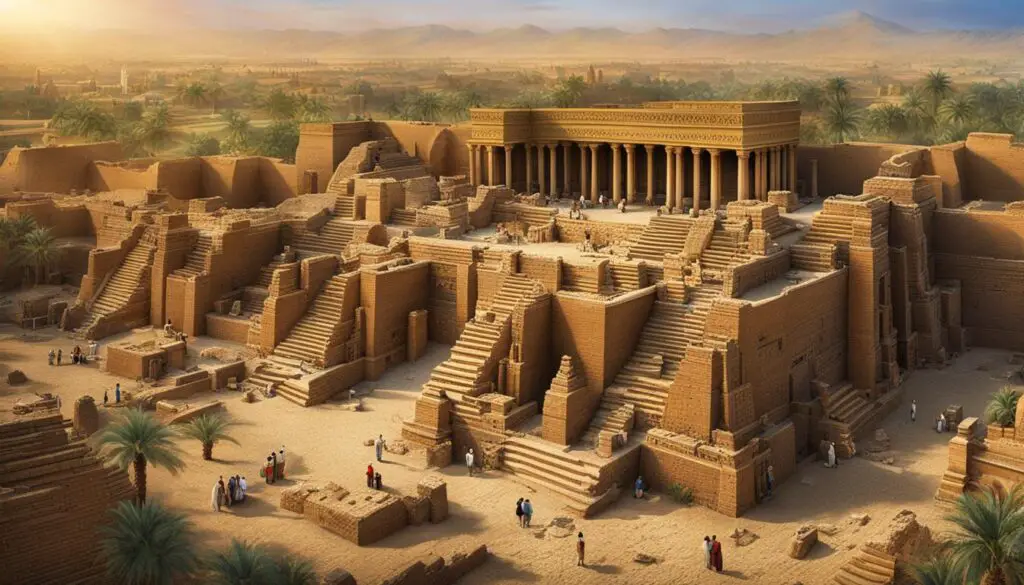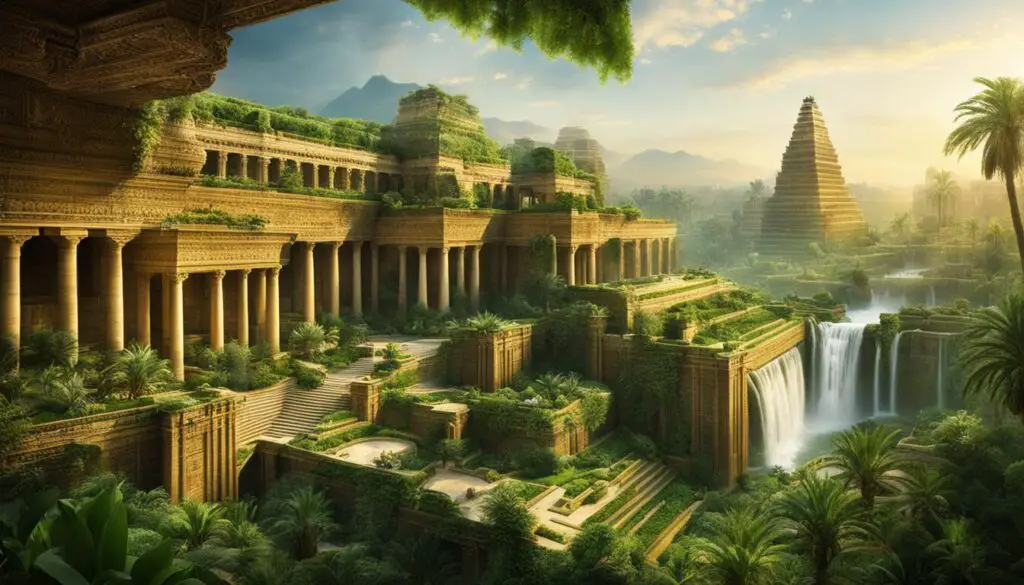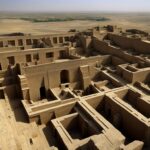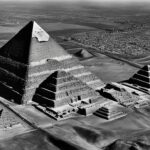Welcome to a journey back in time, where we uncover the mysteries and marvels of ancient Babylon. Step into a world steeped in history, and discover the cultural heritage of one of the most significant civilizations in the ancient world. From its biblical importance to its architectural wonders, Babylon continues to captivate and inspire people from all walks of life.
Babylon, located in present-day Iraq, was a thriving city founded by the ancient Akkadian-speaking people of southern Mesopotamia in 2300 B.C. This ancient civilization flourished under the rule of Hammurabi, who unified southern and central Mesopotamia into the Babylonian Empire. Over the centuries, Babylon rose and fell, leaving behind traces of a rich and influential past.
Notable biblical figures, such as King Nebuchadnezzar and the prophet Daniel, are linked to Babylon. The city played a significant role in Jewish history during the Babylonian exile, where thousands of Jews were held captive. These biblical events have shaped the historical significance of Babylon, leaving an indelible mark on the city’s cultural legacy.
In its glory days, Babylon stood as a testament to architectural splendor. The city boasted massive walls and the famous Ishtar Gate, adorned with vibrant blue glazed bricks and intricate animal motifs. Inside, grand palaces and temples, including the awe-inspiring shrine dedicated to the god Marduk, showcased the wealth and power of the Babylonian civilization. Explore the ruins and imagine the greatness that once filled these streets.
Major biblical events, such as the Babylonian conquest of the Kingdom of Judah and the fall of Babylon to the Persians, have shaped its history. These events marked shifts in power and cultural dynamics, leaving lasting impacts on Babylon’s historical narrative.
Today, Babylon welcomes eager visitors from around the world who are drawn to its ancient ruins and intriguing past. Explore the remnants of palaces, temples, and the famous Ishtar Gate, providing a glimpse into the grandeur and achievements of the Babylonian civilization. Delve into the symbolism, mythology, and cultural significance that continue to make Babylon a captivating destination.
Key Takeaways:
- Babylon, an ancient city located in present-day Iraq, was a major center of civilization and holds great historical significance.
- Notable biblical figures like King Nebuchadnezzar and the prophet Daniel are associated with Babylon.
- Babylon was renowned for its impressive architecture, including massive walls, the Ishtar Gate, and grand palaces.
- Major biblical events, like the Babylonian conquest and the fall of Babylon, impacted its history.
- Today, Babylon is a destination for tourists eager to explore its ancient ruins and cultural heritage.
Location and Historical Significance of Babylon
The ancient city of Babylon was situated about 50 miles south of Baghdad, along the Euphrates River in present-day Iraq. It was a prominent city in the ancient world and holds great historical significance. Babylon served as the capital of the Neo-Babylonian Empire and was a center of trade, politics, and culture. This magnificent city played a crucial role in shaping the course of ancient history.
Babylon was known for its advanced architectural achievements, which included the famous Hanging Gardens. These gardens were considered one of the Seven Wonders of the Ancient World and showcased the engineering and horticultural prowess of the Babylonian civilization. The city’s cultural influence extended throughout the region, making it a prominent center in ancient Mesopotamia.
Throughout biblical times, Babylon was a symbol of power and prosperity. It is mentioned in both Hebrew and Christian scriptures, depicting the conquest of the Kingdom of Judah by the Babylonian king Nebuchadnezzar II and the subsequent Babylonian exile. Biblical figures such as King Nebuchadnezzar and the prophet Daniel were linked to Babylon, further emphasizing its importance in ancient history.
Overall, the location of Babylon and its historical significance make it a fascinating destination for those interested in exploring the ancient world. The remnants of its grand architecture and cultural achievements are a testament to the greatness of the Babylonian empire and its enduring impact on human history.
Biblical Significance of Babylon and Notable Figures
Babylon holds a significant place in biblical history and is mentioned in both Hebrew and Christian scriptures. It played a crucial role in the conquest of the Kingdom of Judah by the Babylonian king Nebuchadnezzar II, leading to the Babylonian exile. Notable biblical figures linked to Babylon include King Nebuchadnezzar and the prophet Daniel. Here, we explore the biblical importance of Babylon and its association with these figures.
In the Old Testament, King Nebuchadnezzar is a prominent figure who played a major role in the Babylonian Empire and the captivity of the Jews. He is famously known for dreaming of a great statue and seeking Daniel’s interpretation. Daniel, a prophet and advisor to Nebuchadnezzar, became renowned for his ability to interpret dreams, including the king’s vision of the statue representing the rise and fall of empires. His story showcases the divine intervention and guidance sought by the people of Babylon.
“Then King Nebuchadnezzar fell upon his face and paid homage to Daniel and commanded that an offering and incense be offered up to him. The king answered and said to Daniel, ‘Truly, your God is God of gods and Lord of kings, and a revealer of mysteries.'” – Daniel 2:46-47
The biblical narratives depict Babylon as a powerful and influential city in ancient times, associated with significant events and characters. The stories of King Nebuchadnezzar and Daniel offer insights into the cultural, religious, and political dynamics of Babylon during biblical times.
Biblical Figures Linked to Babylon
Several notable biblical figures are linked to Babylon, showcasing its importance in religious texts.
- Nebuchadnezzar II: The Babylonian king who conquered Judah, destroyed the Temple of Solomon, and initiated the Babylonian exile.
- Daniel: A prophet and advisor to Nebuchadnezzar, known for his interpretation of dreams and his unwavering faith in God.
- Belshazzar: The last king of Babylon, featured in the famous story of the writing on the wall.
- Cyrus the Great: The Persian king who conquered Babylon and allowed the Jews to return to their homeland.
These figures played significant roles in the biblical narratives, shaping the historical and spiritual importance of Babylon.
The Function and Appearance of Babylon in Biblical Times
Babylon was a powerful city in ancient times, known for its military might, cultural influence, and architectural splendor. It served as the capital of the Babylonian Empire and was a center of trade, politics, and religion. The city was characterized by its grand palaces, temples, and intricate infrastructure. The Hanging Gardens of Babylon, one of the Seven Wonders of the Ancient World, showcased the advanced engineering and horticultural skills of the Babylonians.
Babylon’s appearance reflected its status as a global superpower, with towering walls, majestic structures, and opulent designs. The city’s architectural achievements symbolized the wealth, power, and artistic prowess of the Babylonian civilization. It stood as a testament to human ingenuity and ambition, as well as a reminder of the consequences of pride and arrogance.
While the ruins of Babylon may not resemble their former glory, they still bear witness to the historical and biblical significance of the city. Exploring these ruins allows us to glimpse into the grandeur and achievements of Babylonian civilization in biblical times.
Architecture and Design of Babylon
Babylon was renowned for its impressive architecture and design. The city was enclosed by massive walls, which were further fortified by Nebuchadnezzar II, reaching a height of 40 feet. The walls of Babylon served as a symbol of strength and power, providing protection to the city and its inhabitants. These walls were built using sun-dried clay bricks and covered a perimeter of approximately 10 miles, enclosing not only the city but also its many palaces, temples, and gardens.

The most famous architectural landmark of Babylon is the magnificent Ishtar Gate. This grand entrance gate was adorned with bright blue glazed bricks and intricate animal motifs, representing the deities of the Babylonian pantheon. The Ishtar Gate stood as a testament to the artistic skill and craftsmanship of the Babylonians, showcasing their mastery in ceramics and tilework. The gate served as the main entrance to the city, welcoming visitors and reflecting the grandeur of Babylon’s empire.
Inside the city, Nebuchadnezzar II built grand palaces and temples, including the towering shrine dedicated to the god Marduk. The palaces of Babylon featured intricate carvings, decorative motifs, and lush gardens that added to the overall splendor of the city. The Hanging Gardens of Babylon, another marvel of Babylonian architecture, were known for their terraced gardens, cascading waterfalls, and exotic plant life. These gardens were considered one of the Seven Wonders of the Ancient World, testifying to the engineering and horticultural expertise of the Babylonians.
Major Events and Impact on History
Babylon, with its rich biblical history, witnessed several major events that had a profound impact on its history and legacy. These events shaped the city’s political landscape, cultural dynamics, and religious significance in biblical times. Understanding these major biblical events is essential to appreciate the historical significance of Babylon as an ancient city.
“When Nebuchadnezzar II conquered the Kingdom of Judah, it marked a significant turning point in the history of Babylon. The Babylonian exile that followed resulted in the captivity of thousands of Jews in Babylon. This event not only impacted the Jewish people but also brought about cultural and religious exchanges between Babylonians and Jews, shaping the cultural fabric of the city.”
Furthermore, the fall of Babylon to the Persians, led by Cyrus the Great, was another major event of biblical significance. This marked the end of the Neo-Babylonian Empire and the rise of the Persian Empire. The conquest of Babylon by the Persians had far-reaching consequences, not only politically but also in terms of cultural shifts and power dynamics in the region.
These major biblical events had a lasting impact on Babylon’s history, leading to changes in its ruling powers, religious practices, and cultural identity. The city played a significant role in Jewish history and shaped the religious narratives and symbolism associated with Babylon. Its historical significance as a site of major biblical events continues to fascinate historians, archaeologists, and religious scholars alike.
Biblical Events in Babylon:
| Event | Impact |
|---|---|
| The conquest of the Kingdom of Judah by Nebuchadnezzar II | Resulted in the Babylonian exile and cultural exchanges between Babylonians and Jews |
| The fall of Babylon to the Persians led by Cyrus the Great | Marked the end of the Neo-Babylonian Empire and the rise of the Persian Empire |
These events not only transformed the political landscape of Babylon but also left a lasting impact on its cultural and religious identity. The biblical narratives surrounding these events have shaped the historical significance of Babylon and continue to resonate with people today.
Through the lens of these major biblical events, we can gain a deeper understanding of the multifaceted history and legacy of Babylon. Its importance in biblical times as a center of power, cultural exchange, and religious significance continues to intrigue and inspire exploration into the ancient city’s past.
Babylonian Mythology and Legends
Babylonian mythology and legends have played a significant role in shaping the cultural identity of ancient Babylon. These stories have been passed down through generations, capturing the imagination and curiosity of people throughout history. One of the most well-known Babylonian myths is the tale of the Tower of Babel, which has its roots in both biblical and ancient Mesopotamian sources.
The Tower of Babel myth tells the story of a large tower built by the people of Babylon who sought to reach the heavens. In response to their arrogance, the gods confound their language, causing them to speak different tongues and scattering them across the earth. This myth serves as a cautionary tale against human hubris and the consequences of overreaching.
“Come, let us build ourselves a city, with a tower that reaches to the heavens, so that we may make a name for ourselves; otherwise we will be scattered over the face of the whole earth.” – Genesis 11:4
Another legendary wonder associated with Babylon is the Hanging Gardens of Babylon. Considered one of the Seven Wonders of the Ancient World, these gardens were said to be an engineering marvel, featuring terraced gardens with lush greenery and exotic plants. While the exact location and existence of the Hanging Gardens remain a subject of debate among scholars, their legend has persisted throughout history, capturing the imagination of artists, writers, and historians.
The Tower of Babel
The myth of the Tower of Babel, also mentioned in the book of Genesis in the Bible, is deeply ingrained in the cultural heritage of Babylon. This ancient myth highlights the consequences of human pride and the limits of human power in the face of divine intervention. According to the legend, the people of Babylon sought to build a tower that would reach the heavens, believing that they could make a name for themselves and establish their greatness.
The gods, angered by their audacity, confounded their language, causing them to speak different tongues and scattering them across the earth. This divine intervention not only disrupted the construction of the tower but also led to the dispersion of humanity and the origin of different languages. The myth of the Tower of Babel serves as a cautionary tale, reminding humanity of the dangers of excessive pride and the importance of humility.
The Hanging Gardens of Babylon
The Hanging Gardens of Babylon, often considered one of the Seven Wonders of the Ancient World, have captivated the imagination of people for centuries. These legendary gardens were said to be an architectural marvel, featuring terraced gardens with lush greenery and beautiful plants. They were believed to have been built by King Nebuchadnezzar II for his wife, who longed for the green landscapes of her homeland.
While the exact location and existence of the Hanging Gardens remain uncertain, the legend surrounding them has left a lasting impact on Babylonian mythology and cultural heritage. The gardens symbolize the power of human ingenuity and the desire to create beauty even in the midst of arid landscapes. Their legend continues to inspire awe and wonder, highlighting the imaginative and ambitious nature of the Babylonian civilization.
| Key Elements of Babylonian Mythology | Description |
|---|---|
| The Tower of Babel | A mythological story about the construction of a tall tower by the people of Babylon, leading to divine intervention and the dispersion of humanity. |
| The Hanging Gardens of Babylon | A legendary wonder featuring terraced gardens with lush greenery and exotic plants, believed to have been built by King Nebuchadnezzar II. |
| Diverse Pantheon | The Babylonian mythology featured a rich and diverse pantheon of gods and goddesses, each with their own unique attributes and roles in the celestial hierarchy. |
| Epic of Gilgamesh | An ancient Babylonian epic poem that tells the story of Gilgamesh, a legendary king who embarks on a quest for immortality. |
Excavations and Restoration of Babylon
Babylon, the ancient city steeped in rich history and cultural significance, has undergone extensive excavations and restoration efforts throughout the years. These endeavors have aimed to uncover the secrets of this magnificent city and preserve its heritage for future generations to appreciate and learn from.
German archaeologist Robert Koldewey played a pivotal role in the excavation of Babylon during the late 19th and early 20th centuries. His meticulous work revealed the impressive architectural and cultural treasures hidden beneath the earth’s surface. From grand palaces and temples to the iconic Ishtar Gate, the excavations provided invaluable insights into the city’s architectural prowess and artistic achievements.
However, in recent times, Babylon has suffered significant damage due to external factors. The invasion of Iraq and subsequent military presence resulted in the construction of a military base on the ruins of Babylon, leading to the destruction of certain areas. These unfortunate events have underscored the importance of ongoing restoration efforts to ensure the preservation of Babylon’s historical legacy.
Efforts are being made to restore and safeguard the site, but more conservation work and research are needed to fully protect Babylon’s cultural heritage. The damage inflicted on this ancient city serves as a sobering reminder of the challenges faced in preserving our shared human history. It is crucial that we continue to support the restoration initiatives and raise awareness about the significance of Babylon, both as a historical site and a symbol of our collective past.

Babylon Today and Tourism
Babylon, once a thriving ancient city, continues to captivate tourists from around the world today. Despite the challenges posed by the geopolitical situation, the Iraqi government has reopened Babylon to visitors, allowing them to step back in time and explore the wonders of this ancient civilization.
When visiting present-day Babylon, tourists have the opportunity to explore the remnants of palaces, temples, and the iconic Ishtar Gate. This gate, adorned with bright blue glazed bricks and intricate animal motifs, served as the main entrance to the city and showcases the artistic mastery of the Babylonian civilization. The site also provides a glimpse into the grandeur and architectural achievements of the ancient city, leaving visitors in awe of its historical significance.
As travelers wander through the ruins of Babylon, they are transported to a time of great cultural and historical importance. From the towering palaces to the remnants of the famous Hanging Gardens, visitors can immerse themselves in the rich heritage of the Babylonian civilization. Exploring the ancient streets and imagining the bustling city that once stood here creates a sense of wonder and excitement.
“Visiting Babylon was like taking a journey back in time. The magnitude of the ruins and the stories they hold truly make you appreciate the splendor and influence of this ancient city.” – Traveler
Babylon Today: A Cultural Treasure
Babylon’s tourism sector plays a crucial role in preserving and promoting the cultural legacy of this ancient city. By welcoming visitors from near and far, Babylon sparks curiosity and fosters an appreciation for ancient civilizations. The site serves as a reminder of the incredible achievements of humanity and the need to protect our cultural heritage for future generations.
| Key Attractions in Present-Day Babylon | Highlights |
|---|---|
| The Ishtar Gate | The famous gate adorned with blue glazed bricks and animal motifs |
| The Hanging Gardens | Recreated in their splendor, showcasing the architectural prowess of the Babylonians |
| Palaces and Temples | Remnants of grand structures that once stood in Babylon, offering a glimpse into the opulence of the past |
| Ancient Streets | Wander through the ancient streets, imagining the vibrant city that once thrived on these very paths |
Cultural Significance of Babylon
The ancient city of Babylon holds immense cultural significance that extends far beyond its historical and architectural achievements. Throughout history, Babylon has served as an inspiration for art, literature, and religious traditions, leaving a lasting impact on human culture.
The influence of Babylon on art and literature can be seen in various forms. Babylonian mythology, with its rich narratives and legends, has inspired countless works of literature, both ancient and modern. One of the most famous examples is the biblical story of the Tower of Babel, which has been retold and interpreted in literature and art for centuries.
“The legends and architectural wonders of Babylon continue to captivate the imagination, making it a symbol of power, mythology, and the human desire to reach greatness.”
Furthermore, Babylon’s architectural marvels have been a source of inspiration for artists and architects throughout the ages. The Hanging Gardens of Babylon, considered one of the Seven Wonders of the Ancient World, have been depicted in paintings, sculptures, and written descriptions, showcasing their allure and beauty.
The cultural legacy of Babylon can also be seen in religious traditions. The city’s association with notable biblical events, such as the Babylonian exile of the Jews and the reign of King Nebuchadnezzar, has shaped religious practices and beliefs across different faiths. Babylon’s historical significance and biblical importance make it a place of great reverence and interest for religious scholars and followers.
| Art | Literature | Religion |
|---|---|---|
| Babylonian mythology inspires artistic works | Biblical stories linked to Babylon are reinterpreted in literature | Babylon’s biblical importance influences religious practices |
| Hanging Gardens of Babylon depicted in paintings and sculptures | The Tower of Babel story serves as a source of inspiration | Religious scholars study Babylon’s historical significance |
| Architectural marvels of Babylon influence architectural design | Babylonian legends and narratives shape literary works | Babylon’s association with biblical figures impacts religious beliefs |
The cultural significance of Babylon is a testament to the enduring impact of ancient civilizations on our present-day world. Its influence on art, literature, and religious traditions showcases the power of human imagination and the lasting legacy of historical and cultural heritage. Babylon will continue to be a symbol of power, mythology, and the human desire for greatness, captivating the imagination of people for generations to come.

The Symbolism and Legacy of Babylon
Babylon, an ancient city of great historical and cultural significance, holds a profound symbolism that has transcended time. Its legacy is rooted in both the heights of human achievement and the consequences of human arrogance and downfall. The city’s legends and architectural wonders continue to captivate the imagination, leaving a lasting impact on our understanding of ancient civilizations and the human condition.
In biblical history, Babylon played a notable role, particularly during the Babylonian exile. The city’s conquest of the Kingdom of Judah by King Nebuchadnezzar II led to the captivity of thousands of Jews. This significant biblical event highlights Babylon’s power and influence in ancient times, further cementing its place in history.
The symbolism of Babylon also extends to its architectural marvels. The Hanging Gardens of Babylon, one of the Seven Wonders of the Ancient World, are a testament to human ingenuity and horticultural prowess. The towering Ishtar Gate, adorned with bright blue glazed bricks and intricate animal motifs, exemplifies the city’s architectural achievements. These structures stand as a reminder of the grandeur and cultural prowess of the Babylonian civilization.
| Symbolism of Babylon | Legacy of Babylon |
|---|---|
| The rise and fall of empires | A lasting impact on human history |
| The consequences of human arrogance | Inspiration for artistic and literary works |
| Biblical significance and cultural legacy | Captivating the imagination of people worldwide |
The symbolism and legacy of Babylon have shaped our understanding of ancient civilizations, marking it as a significant cultural and historical landmark. The city’s association with biblical events, architectural wonders, and cultural achievements continues to inspire awe and curiosity. As we explore the ruins and unravel the mysteries of ancient Babylon, we gain insights into the rise and fall of empires, the resilience of civilizations, and the enduring impact of cultural heritage on our present-day world.

Conclusion
The ancient city of Babylon holds immense historical significance and serves as a remarkable testament to the cultural heritage of the Babylonian civilization. This legendary city, with its rich biblical importance, has captured the imagination of people throughout history.
Babylon was closely intertwined with notable biblical figures such as King Nebuchadnezzar and the prophet Daniel, who played significant roles in the old testament. The city’s architectural marvels, including the towering shrines and the famous Ishtar Gate, showcased the grandeur and splendor of Babylonian design and craftsmanship.
Major biblical events, such as the Babylonian conquest of the Kingdom of Judah and the subsequent Babylonian exile, had a profound impact on Babylon’s history. These events shaped the power dynamics and cultural landscape of the city, leaving behind a lasting legacy.
Today, Babylon continues to attract tourists from around the world, offering them the opportunity to explore its ancient ruins and discover the wonders of this ancient civilization. As preservation and restoration efforts continue, the historical significance and cultural heritage of Babylon are safeguarded for future generations to appreciate and admire.
FAQ
When was Babylon founded?
Babylon was founded in 2300 B.C. by the ancient Akkadian-speaking people of southern Mesopotamia.
Where is Babylon located?
Babylon is located in present-day Iraq, about 50 miles south of Baghdad, along the Euphrates River.
What is the historical significance of Babylon?
Babylon was a major military power and became the most powerful state in the world under the Neo-Babylonian Empire. It played a significant role in Jewish history during the Babylonian exile.
What notable biblical figures are associated with Babylon?
King Nebuchadnezzar and the prophet Daniel are notable biblical figures associated with Babylon.
What are some architectural achievements of Babylon?
Babylon was known for its massive walls, the famous Ishtar Gate, grand palaces, and temples.
What major events took place in Babylon?
The Babylonian conquest of the Kingdom of Judah led to the Babylonian exile, and the fall of Babylon to the Persians marked the end of the Neo-Babylonian Empire.
What is the cultural significance of Babylon?
Babylon’s myths, legends, and architectural wonders have inspired art, literature, and religious traditions throughout history.
What is the current state of Babylon’s ruins?
Babylon has undergone excavations and restoration efforts, but it has also suffered damage due to military presence. Conservation and research are ongoing.
Can tourists visit Babylon today?
Yes, the Iraqi government has reopened Babylon to tourists, allowing them to explore the ancient ruins.
How does Babylon symbolize human achievement and downfall?
Babylon represents both the heights of human achievement and the consequences of human arrogance and downfall, as depicted in its myths and legends.
What is the legacy of Babylon?
The legacy of Babylon lies in its ability to inspire awe, reflection, and an appreciation for cultural heritage and the rise and fall of empires.







